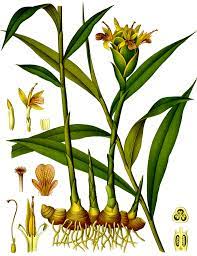Since I am doing a course from Commonwealth Herbs, I am trying to do my herb of the month in the order that I am learning the herbs. Which is going to be challenging because I am learning about so many herbs so fast! So I figure that from here on out, I will be doing herbs that stand out as personal herb allies.
I learned a lot about ginger before even doing the research for this monograph because I started to get sick the week before doing this research. One of the things that I have loved about the classes I am taking with Commonwealth Herbs is that I got some actionable herbal information very quickly. Apparently a tea made with dried ginger and thyme is great for heading off a cold that is trying to come on. My daughter got sick a week ago and of course I almost immediately felt like I was getting sick as well. I made the ginger and thyme tea and drank it throughout two days. I also did several thyme steams, another thing that they swear by. And wouldn’t you know it – now I am typing this with no cold symptoms whatsoever. I was able to talk both of my daughters into trying the thyme steam, and both of them said that they felt that it helped their cold symptoms.
Ginger
Scientific Name: Zingiber Officinales
Family: Zingiberaceae
Parts Used: Rhizome/Root
Native To: Southeast Asia
Botanical Description: A reedy, leafy stemmed perennial (having a cycle lasting longer than two years) that grows up to two feet, ginger shoots up a tall stem in the spring and has lanceolate leaves. The flower stalk grows from the root and at the tip, develops an oblong and scalloped spike from which white or yellow flowers blossom. It has become so widely cultivated in tropical and subtropical regions of the world that it is rarely found growing wild. Cultivated propagation has been done by root cuttings for so long that many cultivars no longer produce seeds. Z. officinales prefers warm, sunny, humid, low altitude locations and medium loamy, well drained, highly fertile soil.
Taste: Pungent, bittersweet; warm, moist; diffusive, stimulating
Energetic Properties: Warming, Drying
Tissue State: depression, constriction, atrophy
Actions: stimulant, carminative, rubefacient, diffusive, relaxant, antispasmodic, antiemetic, anodyne, emmenagogue, diaphoretic
Affinities: digestive, circulatory, and reproductive systems
Notable Constituents: volatiles, 1-3% (zingiberene 20-30%), oleoresin 4-7.5% (gingerol, shogaols), sesquiterpenoids, lipids
Medicinal Applications:
- Archetypal carminative – warming remedy to support healthy gastrointestinal function and increase digestive fire. Indicated for cold conditions in the GI tract manifesting as indigestion or sluggish, incomplete digestion. Relieves pain by warming and reducing spasms and constrictions. Improves digestion, bile secretion, fat digestion, and movement of food through the digestive tract, reducing stagnation, irritation, and gas. Can help relieve colic, abdominal pain, distension, flatulence, and the griping pain associated with diarrhea.
- Antiemetic – for all forms of nausea, including those from food poisoning, medications (including chemotherapy), morning sickness, and motion sickness. Also prevents and expels worms and parasites.
- Diaphoretic – helpful for encouraging healthy fever response to infection. This can lead to sweating, which can then cool the body. Increases arterial circulation, which can lead to warming of extremities. Helpful during cold or flu as it raises body temperature, making the body inhospitable for pathogens.
- Emmenagogue – warming and soothing for uterine cramping. Encourages blood flow when experiencing slow, scant menstrual flow.
- Circulatory Stimulant – thins the blood, improves circulation, nourishing tissues and clearing away stagnant fluids.
In Practice:
- Commonly used in tea blends for gut health/support of digestion. Commonly used in tea blends for painful menstruation cycles with scant bleeding, or when someone does not experience heavy bleeding.
- As a tincture, helpful for severe nausea, when someone can’t keep anything down. Candied ginger is helpful for nausea as well.
- Anodyne (relieves pain) – for cold, constriction-type headaches such as tension headaches, migraines, cluster headaches. Form the powdered ginger into a plaster with water, apply on paper or cloth to the forehead.
- Fresh ginger is diffusive, moving blood and warmth outwards toward the surface and periphery. This method is good for colds and flus.
- Dried ginger is more centrally warming, heating the core. This works well for digestion and reproductive systems.
Preparations: Z. officinales can be prepared as an infusion, decoction, tincture, extract, glycerite, honey, oil, salve, compress, ginger beer, ginger wine, and food.
Cautions: Ginger has a blood thinning effect. Use caution if taking blood-thinning medications. Ginger’s emmenagogue action will increase the menstrual flow of those with already heavy cycles. Can be too warming for some people. Dried ginger in a bath can cause severe irritation to sensitive tissues.
Friends: turmeric, galangal, cardamom, chamomile, fennel, garlic, calamus
Resources:
Commonwealth Holistic Herbalism Course Work
Ginger Monograph. Maxine Hughston, Herbalist, Massage Therapist. https://www.maxtheherbalist.com/myplantallies/ginger-monograph. Sept 18. Accessed Oct 17, 2021
Zinziber – Ginger. Henriette’s Herbal Homepage. https://www.henriettes-herb.com/eclectic/kings/zingiber.html . Accessed Oct 17, 2021.
Wood, Matthew. The Earthwise Herbal: A Complete Guide to Old World Medicinal Plants. Berkeley, CA. North Atlantic Books, 2009. Pgs 533 – 537 Print.
Ginger Monograph. The Herbarium by The Herbal Academy. https://herbarium.theherbalacademy.com/monographs/#/monograph/1012 . Accessed Oct 17, 2021.
Disclaimer: The above information is for education purposes only and has not been evaluated by the Food and Drug Administration. It is not intended to diagnose, treat, cure, or prevent any disease.
